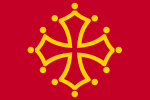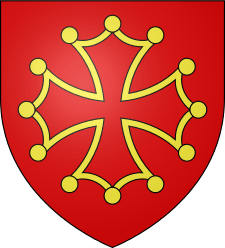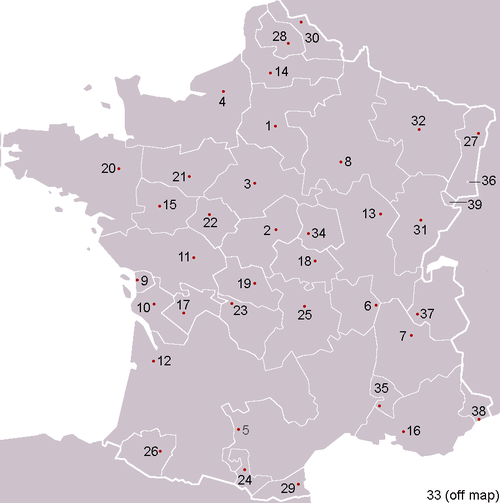Languedoc
| Languedoc | |||
|---|---|---|---|
| |||
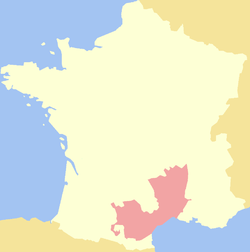 | |||
| Country | France | ||
| Time zone | CET | ||
Languedoc (/ˌlɒŋɡəˈdɒk/ ; French: [lɑ̃ɡ.dɔk] ; Occitan: Lengadòc [ˌleŋɡɔˈðɔ]) is a former province of France. Its territory is now contained in the modern-day region of Occitanie in the south of France. Its capital city was Toulouse. It had an area of approximately 27,376 square kilometers (10,570 square miles).
Geographical extent
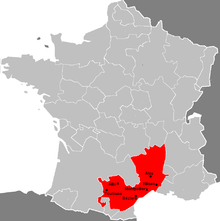
The traditional provinces of the kingdom of France were not formally defined. A province was simply a territory of common traditions and customs, but it had no political organization. Today, when people refer to the old provinces of France, they actually refer to the gouvernements as they existed in 1789. Gouvernements were military regions established in the middle of the 16th century and whose territories closely matched those of the traditional provinces. However, in some cases, small provinces had been merged with a large one into a single gouvernement, so gouvernements are not exactly the same as the traditional provinces.
Historically, the region was called the county of Toulouse, a county independent from the kings of France. The county of Toulouse was made up of what would later be called Languedoc, but it also included the province of Quercy (now département of Lot and northern half of the département of Tarn-et-Garonne) and the province of Rouergue (now département of Aveyron), both to the northwest of Languedoc. At some times it even included the province of Agenais (now eastern half of the département of Lot-et-Garonne) to the west of Languedoc, the province of Gévaudan (now département of Lozère), the province of Velay (now the central and eastern part of the département of Haute-Loire), the southern part of the province of Vivarais (now the southern part of the département of Ardèche), and even all the northern half of Provence. After the French conquest the entire county was dismantled, the central part of it being now called Languedoc.
The gouvernement of Languedoc was created in the middle of the 16th century. In addition to Languedoc proper, it also included the three small provinces of Gévaudan, Velay, and Vivarais (in its entirety), these three provinces being to the northeast of Languedoc. Some people also consider that the region around Albi was a traditional province, called Albigeois (now département of Tarn), although it is most often considered as being part of Languedoc proper. The provinces of Quercy and Rouergue, despite their old ties with Toulouse, were not incorporated into the gouvernement of Languedoc, instead being attached to the gouvernement of Guienne and its far-away capital Bordeaux. This decision was probably intentional, to avoid reviving the independently spirited county of Toulouse. In the rest of the article, Languedoc refers to the territory of this gouvernement of Languedoc.
Area and location of Languedoc
The province of Languedoc covered an area of approximately 42,700 km² (16,490 sq. miles) in the central part of southern France, roughly the region between the Rhône River (border with Provence) and the Garonne River (border with Gascony), extending northwards to the Cévennes and the Massif Central (border with Auvergne).
Old administrative divisions
The governors of Languedoc resided in Pézenas, on the Mediterranean coast, away from Toulouse but close to Montpellier. In time they had increased their power well beyond military matters, and had become the real administrators and executive power of the province, a trend seen in the other gouvernements of France, but particularly acute in Languedoc, where the duke of Montmorency, governor of Languedoc, even openly rebelled against the king, then was defeated and beheaded in Toulouse in 1632 by the order of Richelieu. The kings of France became fearful of the power of the governors, so after King Louis XIV (the Sun King) they had to reside in Versailles and were forbidden to enter the territory of their gouvernement. Thus the gouvernements became hollow structures, but they still carried a sense of the old provinces, and so their names and limits have remained popular until today.

For administrative purposes, Languedoc was divided in two généralités, the généralité of Toulouse and the généralité of Montpellier, the combined territory of the two generalities exactly matching that of the gouvernement of Languedoc. At the head of a generality was an intendant, but in the case of Languedoc there was only one intendant responsible for both generalities, and he was often referred to as the intendant of Languedoc, even though technically speaking he was in fact the intendant of the generality of Toulouse and intendant of the generality of Montpellier. The generality of Toulouse is also referred to as Upper Languedoc (Haut-Languedoc), while the generality of Montpellier, down to the level of the sea, is referred to as Lower Languedoc (Bas-Languedoc). The intendants of Languedoc resided in Montpellier, and they had a sub-delegate in Toulouse. Montpellier was chosen on purpose to diminish the power of Toulouse, whose parlement was very influential, and which symbolized the old spirit of independence of the county of Toulouse. The intendants replaced the governors as administrators of Languedoc, but appointed and dismissed at will by the king, they were no threat to the central state in Versailles. By 1789 they were the most important element of the local administration of the kingdom.
For judicial and legislative matters, Languedoc was overseen by the Parlement of Toulouse, founded in the middle of the 15th century. It was the first parlement created outside of Paris by the kings of France in order to be the equivalent of the Parlement of Paris in the far-away southern territories of the kingdom. The jurisdiction of the Parlement of Toulouse included the whole of the territory of the gouvernement of Languedoc, but it also included the province of Rouergue, most of the province of Quercy, and a part of Gascony. The Parlement of Toulouse was the supreme court of justice for this vast area of France, the court of last resort whose rulings could not be appealed, not even to the Parlement of Paris. The Parlement of Toulouse could also create case law through its decisions, as well as interpret the law. It was also in charge of registering new royal edicts and laws, and could decide to block them if it found them to be in contravention with the liberties and laws of Languedoc.
Finally, for purposes of taxation, Languedoc was ruled by the States of Languedoc, whose jurisdiction included only Languedoc proper (and Albigeois), but not Gévaudan, Velay, and Vivarais, which kept each their own provincial states until 1789. Languedoc proper was one of the very few provinces of France which had the privilege to decide over tax matters, the kings of France having suppressed the provincial states in most other provinces of the kingdom. This was a special favor from the kings to ensure that an independently spirited region far-away from Versailles would remain faithful to the central state. The States of Languedoc met in many different cities, and for some time they established themselves in Pézenas, but in the 18th century they were relocated definitively to Montpellier, where they met once a year, until 1789.
For religious purposes, Languedoc was also divided into a certain number of ecclesiastical provinces, including the archdiocese of Toulouse.
Capital
As the center of the County of Toulouse and the regional parlement, Toulouse is often considered the "capital" of Languedoc. On maps (both ancient and modern) showing the provinces (i.e., gouvernements) of France in 1789, it is always marked as such. However, the intricate entanglement of administrations and jurisdictions permitted Montpellier to also claim that distinction. In the 18th century, the monarchy clearly favored Montpellier, a city much smaller than Toulouse, with less history, and with fewer autonomous local authorities such as Toulouse's parlement and capitoulate.
Modern administrative divisions
The province of Languedoc has been divided between four modern-day régions:
- 55.5% of its former territory lies in the Languedoc-Roussillon région, capital city Montpellier, covering the départements of Gard, Hérault, Aude, Lozère, and the extreme-north of Pyrénées-Orientales, which account for 86.5% of the territory of Languedoc-Roussillon. The remaining 13.5% is Roussillon (Pyrénées-Orientales), a province which was never part of Languedoc historically.
- 24.8% of its former territory lies in the Midi-Pyrénées région, capital city Toulouse, covering the département of Tarn, as well as the eastern half of Haute-Garonne, the southeast of Tarn-et-Garonne, and the northwest and northeast of Ariège, which account for 23.4% of the territory of Midi-Pyrénées. The remaining 76.6% is made of Quercy and Rouergue (of which was talked above), as well as the province of County of Foix (which had been a vassal of the county of Toulouse in the Middle Ages), several small provinces of the Pyrénées mountains, and a large part of Gascony.
- 13% lies in the Rhône-Alpes région, covering the département of Ardèche, which accounts for 12.7% of the territory of Rhône-Alpes
- 6.7% lies in the Auvergne région, covering the central and eastern part of the département of Haute-Loire, which account for 11% of the territory of modern-day Auvergne région
Population and cities
On the traditional territory of the province of Languedoc there live approximately 3,650,000 people (as of 1999 census), 52% of these in the Languedoc-Roussillon région, 35% in the Midi-Pyrénées région, 8% in the Rhône-Alpes région, and 5% in the Auvergne région.
The territory of the former province shows a stark contrast between some densely populated areas (coastal plains as well as metropolitan area of Toulouse in the interior) where density is between 150 inhabitants per km²/390 inh. per sq. mile (coastal plains) and 300 inh. per km²/780 inh. per sq. mile (plain of Toulouse), and the hilly and mountainous interior where density is extremely low, the Cévennes area in the south of Lozère having one of the lowest densities of Europe with only 7.4 inhabitants per km² (19 inh. per sq. mile).
The five largest metropolitan areas on the territory of the former province of Languedoc are (as of 1999 census): Toulouse (964,797), Montpellier (459,916), Nîmes (221,455), Béziers (124,967), and Alès (89,390).
The population of the former province of Languedoc is currently the fastest-growing in France, and also among the fastest-growing in Europe, as an increasing flow of people from northern France and the north of Europe relocating to the sunbelt of Europe, in which Languedoc is located. Growth is particularly strong in the metropolitan areas of Toulouse and Montpellier, which are the two fastest growing metropolitan areas in Europe at the moment. However, the interior of Languedoc is still losing inhabitants, which increases the difference of density that was mentioned.
Population of the coast of Languedoc as well as the region of Toulouse is rather young, educated, and affluent, whereas in the interior the population tends to be much older, with significantly lower incomes, and with a lower percentage of high school and especially college graduates.
Economy
Agriculture
Languedoc is a significant producer of wine, and a major contributor to the surplus known as the "wine lake". Today it produces more than a third of the grapes in France, and is a focus for outside investors. Wines from the Mediterranean coast of Languedoc are labeled as Languedoc, those from the interior have other labels such as Fronton, Gaillac, or Limoux to the west – and Côtes du Rhône towards east.
Other crops include wheat (the traditional crop which made the fortune of the landlords and parliamentarians based in Toulouse, and for whose trade the famous Canal du Midi was built), maize (the new and nowadays most popular crop in the region), olives (only on the Mediterranean coast of Languedoc), fruit, and rice (in some coastal areas). In the hilly and mountainous areas of the interior, sheep and goat are raised for meat and cheese. The coastal area is, naturally, a source of fish and shellfish.
Industry

Aerospace (Airbus, CNES, etc.), electronics (Freescale, etc.), and bio-tech industries in Toulouse; high-tech, electronics, and computer (IBM) industries in Montpellier; pharmaceutical industry (Pierre Fabre Group) in Castres.
There is also a significant chemical sector in Toulouse, which has been quite battered since the terrible explosion of AZF on 21 September 2001. It has been decided that chemical industries would be moved out of Toulouse, and a large campus devoted to cancer research and bio-tech R&D will be opened on the site.
Elsewhere in the region industries are small and in decline, in particular around the formerly mining areas of Alès and Carmaux in the interior of the region.
Services and tourism
Services are the largest sector of the economy in the region. In particular, government services employ a significant part of the workforce, especially in small towns. Key administrations have been relocated to the region, such as France's National Meteorology Office (Météo-France) relocated from Paris to Toulouse in 1982.
The area is also a major tourist destination. There exists three types of tourism. First, a massive summer tourism industry on the coast, with huge sea resorts such as Cap d'Agde, Palavas-les-Flots, or Le Grau-du-Roi, built in the 1970s.
Tourism related to history and art is also strong, as the region contains the historic cities of Carcassonne, Toulouse, Montpellier, countless Roman monuments (such as the Roman arenas in Nîmes), medieval abbeys, Romanesque churches, and old castles (such as the ruined Cathar castles in the mountains of Corbières, testimony of the bloody Albigensian Crusade).
More recently, "green" and sports tourism is on the rise, with the gorges of the Tarn River, the Ardèche Gorges, as well as the vast preserved expanses of Cévennes, Ardèche, Lauragais, and other sites.
Tourism on the Canal du Midi combines history (for example viewing the nine locks of Fonseranes near Béziers) with activities such as boating on the Canal, and walking or cycling on the towpaths.
Toulouse and Montpellier are also popular places for business congresses and conventions.
Sports
Rugby union is the "national" sport in Languedoc, unlike most other parts of France where football is more popular. The Toulouse rugby club (Stade Toulousain) is one of the most successful in Europe; it regularly competes for the French championship and has won four European titles (1996, 2003, 2005, and 2010) in the ten years of the European championship's existence.
Bullfighting and other bull-related events are popular in the eastern part of Languedoc. Sea jousts (Joutes nautiques) are held on the coast. Dating from the 11th century, this sport has local leagues and attracts large crowds.
Property
Property in the Languedoc is quite varied and ranges from beautiful newly built villas with swimming pools and tennis courts, to rambling old village houses set into the old ramparts of ancient fortified towns. Some of these village houses date back a very long time. A small house in the village of Magalas, Hérault département, has a date of the 13th century carved into its stonework. Being a large area, the type of property available in Languedoc varies a lot, from apartments in beach resorts such as Cap D'Agde to isolated bastides in the rural interior.
See also
- French wine
- Languedoc wine
- Languedoc-Roussillon
- Midi-Pyrénées
- Occitania
- Septimania timeline
- List of Governors of Languedoc
Notes
External links
| Wikimedia Commons has media related to Languedoc. |
- Languedoc-Roussillon Tourist Board Official Tourism Website for the Region
- The Canal du Midi at Béziers Official Béziers Website
- The Languedoc-Roussillon Official Site of the Région. (French)
- The Hérault tourist board website Department of Hérault in Languedoc Région. All informations to discover Hérault and to book your holidays in Languedoc. Free brochures and lodging.
- An introduction to the Languedoc for tourists including regional overview and main tourist attractions.
- Atlas historique de la province de Languedoc, de l'époque romaine à nos jours, by Élie Pélaquier, CNRS. (French)
- The Languedoc and Roussillon history, geography, climate, cities, towns and historic monuments.
- Quakers end Methodists since 18th century
Coordinates: 43°40′N 3°10′E / 43.667°N 3.167°E
